Portal:Middle Ages/Selected biography
Portal:Middle Ages/Selected biography/1
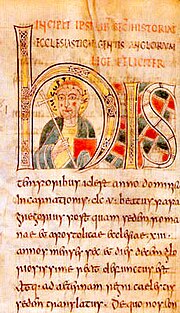
Augustine of Canterbury (circa first third of the 6th century – probably 26 May 604) was a Benedictine monk who became the first Archbishop of Canterbury in the year 597. He is considered the "Apostle to the English" and a founder of the English Church.
Augustine was the prior of a monastery in Rome when Pope Gregory the Great chose him in 595 to lead a mission, usually known as the Gregorian mission, to Britain to Christianize King Æthelberht and his Kingdom of Kent from their native Anglo-Saxon paganism. Kent was probably chosen because Æthelberht had married a Christian princess, Bertha, daughter of Charibert I the King of Paris, who was expected to exert some influence over her husband. Before reaching Kent the missionaries had considered turning back but Gregory urged them on, and in 597 Augustine landed on the Isle of Thanet and proceeded to Æthelberht's main town of Canterbury.
King Æthelberht converted to Christianity and allowed the missionaries to preach freely, giving them land to found a monastery outside the city walls. Augustine was consecrated as a bishop and converted many of the king's subjects, including thousands during a mass baptism on Christmas Day in 597. Pope Gregory sent more missionaries in 601, along with encouraging letters and gifts for the churches, although attempts to persuade the native Celtic bishops to submit to Augustine's authority failed. Roman bishops were established at London and Rochester in 604, and a school was founded to train Anglo-Saxon priests and missionaries. Augustine also arranged the consecration of his successor, Laurence of Canterbury. The archbishop probably died in 604 and was soon revered as a saint. (read more . . . )
Portal:Middle Ages/Selected biography/2
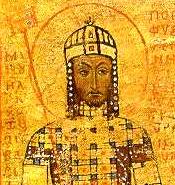
Manuel I Komnenos (or Comnenus) (Greek: Μανουήλ Α' Κομνηνός, Manouēl I Komnēnos) (28 November 1118 – 24 September 1180) was a Byzantine Emperor of the 12th century who reigned over a crucial turning point in the history of Byzantium and the Mediterranean.
Eager to restore his empire to its past glories as the superpower of the Mediterranean world, Manuel pursued an energetic and ambitious foreign policy. In the process he made alliances with the Pope and the resurgent west, invaded Sicily, successfully handled the passage of the dangerous Second Crusade through his empire, and established a Byzantine protectorate over the Crusader states of Outremer. Facing Muslim advances in the Holy Land, he made common cause with the Kingdom of Jerusalem and participated in a combined invasion of Fatimid Egypt. Manuel reshaped the political maps of the Balkans and the eastern Mediterranean, placing the kingdoms of Hungary and Outremer under Byzantine hegemony and campaigning aggressively against his neighbours both in the west and in the east. However, towards the end of his reign Manuel's achievements in the east were compromised by a serious defeat at Myriokephalon, which in large part resulted from his arrogance in attacking a well-defended Seljuk position. Although the Byzantines recovered and Manuel concluded an advantageous peace with Sultan Kilij Arslan II, Myriokephalon proved to be the final, unsuccessful effort by the empire to recover the interior of Anatolia from the Turks. (read more . . . )
Portal:Middle Ages/Selected biography/3
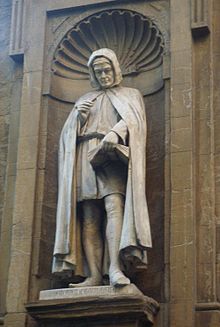
Giovanni Villani (c. 1276 or 1280–1348, Italian pronunciation: [dʒoˈvanni vilˈlaːni]) was an Italian banker, official, diplomat and chronicler from Florence who wrote the Nuova Cronica (New Chronicles) on the history of Florence. He was a leading statesman of Florence but later gained an unsavory reputation and served time in prison as a result of the bankruptcy of a trading and banking company he worked for. His interest in and elaboration of economic details, statistical information, and political and psychological insight mark him as a more modern chronicler of late medieval Europe. His Cronica is viewed as the first introduction of statistics as a positive element in history. However, historian Kenneth R. Bartlett notes that, in contrast to his Renaissance-era successors, "his reliance on such elements as Divine Providence links Villani closely with the medieval vernacular chronicle tradition. In recurring themes made implicit through significant events described in his Cronica, Villani also emphasized three assumptions about the relationship of sin and morality to historical events, these being that excess brings disaster, that forces of right and wrong are in constant struggle, and that events are directly influenced by the will of God.
Villani was inspired to write his Cronica after attending the jubilee celebration in Rome in 1300 and noting the venerable history of that city. He outlined the events in his Cronica year for year, following a strictly linear narrative format. He provided intricate details on many important historical events of the city of Florence and the wider region of Tuscany, such as construction projects, floods, fires, famines, and plagues.
While continuing work on the Cronica and detailing the enormous loss of life during the Black Death in 1348, Villani died of the same illness. His work on the Cronica was continued by his brother and nephew. Villani's work has received both praise and criticism from modern historians. The criticism is mostly aimed at his emphasis on supernatural guidance of events, his organizational style, and his glorification of the papacy and Florence. (read more . . .)
Portal:Middle Ages/Selected biography/4

Tamar the Great (Georgian: თამარი, also transliterated as T'amar or Thamar) (c. 1160 – 18 January 1213), of the Bagrationi dynasty, was Queen Regnant of Georgia from 1184 to 1213. Tamar presided over the "Golden age" of the medieval Georgian monarchy. Her position as the first woman to rule Georgia in her own right was emphasized by the title mep'e ("king"), commonly afforded to Tamar in the medieval Georgian sources.
Tamar was proclaimed heir apparent and co-ruler by her reigning father George III in 1178, but she faced significant opposition from the aristocracy upon her ascension to full ruling powers after George's death. Tamar was successful in neutralizing this opposition and embarked on an energetic foreign policy aided by the downfall of the rival powers of the Seljuqid and the Byzantine empires. Relying on a powerful military élite, Tamar was able to build on the successes of her predecessors to consolidate an empire which dominated the Caucasus until its collapse under the Mongol attacks within two decades after Tamar's death.
Tamar was married twice, her first union being, from 1185 to 1187, to the Rus' prince Yuri, whom she divorced and expelled from the country, defeating his subsequent attempts at coup. For her second consort Tamar chose, in 1191, the Alan prince David Soslan, by whom she had two children, George and Rusudan, the two successive monarchs on the throne of Georgia.
Tamar's association with the period of political and military successes and cultural achievements, combined with her role as a female ruler, has led to her idealization and romantization in Georgian arts and historical memory. She remains an important symbol in Georgian popular culture and has been canonized by the Georgian Orthodox Church as the Holy Righteous Queen Tamar (წმიდა კეთილმსახური მეფე თამარი), with her feast day commemorated on 14 May (O.S. 1 May). read more . . .
Portal:Middle Ages/Selected biography/5

Marco Polo (/ˈmɑːrkoʊ ˈpoʊloʊ/ ⓘ; Italian pronunciation: [ˈmarko ˈpɔːlo]; September 15, 1254 – January 9, 1324) was a Venetian merchant traveler whose travels are recorded in Il Milione, a book which did much to introduce Europeans to Central Asia and China. He learned about trading whilst his father and uncle, Niccolò and Maffeo, travelled through Asia and apparently met Kublai Khan. In 1269, they returned to Venice to meet Marco for the first time. The three of them embarked on an epic journey to Asia, returning after 24 years to find Venice at war with Genoa; Marco was imprisoned, and dictated his stories to a cellmate. He was released in 1299, became a wealthy merchant, married and had three children. He died in 1324, and was buried in San Lorenzo.
His pioneering journey inspired Christopher Columbus and others. Marco Polo's other legacies include Venice Marco Polo Airport, the Marco Polo sheep, and several books and films. He also had an influence on European cartography, leading to the introduction of the Fra Mauro map. (read more . . . )
Portal:Middle Ages/Selected biography/6

Haakon Haakonsson (c. March/April 1204 – 16 December 1263) (Old Norse: Hákon Hákonarson; Norwegian: Håkon Håkonsson), sometimes called Haakon the Old in contrast to his son with the same name, and known in modern regnal lists as Haakon IV, was the King of Norway from 1217 to 1263. His reign lasted for 46 years, longer than any Norwegian king before him. Haakon was born into the troubled civil war era in Norway, but his reign eventually managed to put an end to the internal conflicts. At the start of his reign, during his minority, his later rival Earl Skule Bårdsson served as regent. As a king of the birkebeiner faction, Haakon defeated the uprising of the final bagler royal pretender, Sigurd Ribbung, in 1227. He put a definitive end to the civil war era when he had Skule Bårdsson killed in 1240, a year after he had himself proclaimed king in opposition to Haakon. Haakon thereafter formally appointed his own son as his co-regent.
Under Haakon's rule, medieval Norway is considered to have reached its zenith or golden age. His reputation and formidable naval fleet allowed him to maintain friendships with both the Pope and the Holy Roman Emperor, despite their conflict. He was at different points offered the Imperial Crown by the Pope, the Irish High Kingship by a delegation of Irish kings, and the command of the French crusader fleet by the French king. He amplified the influence of European culture in Norway by importing and translating contemporary European literature into Old Norse, and by constructing monumental European-style stone buildings. In conjunction with this he employed an active and aggressive foreign policy, and at the end of his rule added Iceland and the Norse Greenland community to his kingdom, leaving Norway at its territorial height. Although he for the moment managed to secure Norwegian control of the islands off the northern and western shores of Great Britain, he fell ill and died when wintering in Orkney following some military engagements with the expanding Scottish kingdom. (read more . . . )
Portal:Middle Ages/Selected biography/7

Rhys ap Gruffydd or ap Gruffudd (Anglicised to "Griffith") (1132 – 28 April 1197) was the ruler of the kingdom of Deheubarth in south Wales. He is commonly known as The Lord Rhys, in Welsh Yr Arglwydd Rhys, but this title may not have been used in his lifetime.[1] He usually used the title "Proprietary Prince of Deheubarth" or "Prince of South Wales", but two documents have been preserved in which he uses the title "Prince of Wales" or "Prince of the Welsh".[2] Rhys was one of the most successful and powerful Welsh princes, and after the death of Owain Gwynedd of Gwynedd in 1170 was the dominant power in Wales.
Rhys's grandfather, Rhys ap Tewdwr, was king of Deheubarth, and was killed at Brecon in 1093 by Bernard de Neufmarche. Following his death, most of Deheubarth was taken over by the Normans. Rhys's father, Gruffydd ap Rhys, was eventually able to become ruler of a small portion, and more territory was won back by Rhys's older brothers after Gruffydd's death. Rhys became ruler of Deheubarth in 1155. He was forced to submit to King Henry II of England in 1158. Henry invaded Deheubarth in 1163, stripped Rhys of all his lands and took him prisoner. A few weeks later he was released and given back a small part of his holdings. Rhys made an alliance with Owain Gwynedd and after the failure of another invasion of Wales by Henry in 1165 was able to win back most of his lands.
In 1171 Rhys made peace with King Henry and was confirmed in possession of his recent conquests as well as being named Justiciar of South Wales. He maintained good relations with King Henry until the latter's death in 1189. Following Henry's death Rhys revolted against Richard I and attacked the Norman lordships surrounding his territory, capturing a number of castles. In his later years Rhys had trouble keeping control of his sons, particularly Maelgwn and Gruffydd, who maintained a feud with each other. Rhys launched his last campaign against the Normans in 1196 and captured a number of castles. The following year he died unexpectedly and was buried in St David's Cathedral. (read more . . . )
Portal:Middle Ages/Selected biography/8

William of Tyre (c. 1130 – 29 September 1186) was a medieval prelate and chronicler. As archbishop of Tyre, he is sometimes known as William II to distinguish him from a predecessor, William of Malines. He grew up in Jerusalem at the height of the Kingdom of Jerusalem, which had been established in 1099 after the First Crusade, and he spent twenty years studying the liberal arts and canon law in the universities of Europe.
Following William's return to Jerusalem in 1165, King Amalric I made him an ambassador to the Byzantine Empire. William became tutor to the king's son, the future King Baldwin IV, whom William discovered to be a leper. After Amalric's death, William became chancellor and archbishop of Tyre, two of the highest offices in the kingdom, and in 1179 William led the eastern delegation to the Third Council of the Lateran. As he was involved in the dynastic struggle that developed during Baldwin IV's reign, his importance waned when a rival faction gained control of royal affairs. He was passed over for the prestigious Patriarchate of Jerusalem, and died in obscurity, probably in 1186.
William wrote an account of the Lateran Council and a history of the Islamic states from the time of Muhammad. Neither work survives. He is famous today as the author of a history of the Kingdom of Jerusalem. William composed his chronicle in excellent Latin for his time, with numerous quotations from classical literature. The chronicle is sometimes given the title Historia rerum in partibus transmarinis gestarum ("History of Deeds Done Beyond the Sea") or Historia Ierosolimitana ("History of Jerusalem"), or the Historia for short. It was translated into French soon after his death, and thereafter into numerous other languages. Because it is the only source for the history of twelfth-century Jerusalem written by a native, historians have often assumed that William's statements could be taken at face value. However, more recent historians have shown that William's involvement in the kingdom's political disputes resulted in detectable biases in his account. Despite this, he is considered the greatest chronicler of the crusades, and one of the best authors of the Middle Ages. (Read more...)
Portal:Middle Ages/Selected biography/9
Óengus son of Fergus (Hypothetical Pictish form: Onuist map Urguist;[3] Old Irish: Óengus mac Fergusso, Anglicisation: Angus mac Fergus), was king of the Picts from 732 until his death in 761. His reign can be reconstructed in some detail from a variety of sources.
Óengus became the chief king in Pictland following a period of civil war in the late 720s. During his reign, the neighbouring kingdom of Dál Riata was subjugated and the kingdom of Strathclyde was attacked with less success. The most powerful ruler in Scotland for over two decades, he was involved in wars in Ireland and England. Kings from Óengus's family dominated Pictland until 839 when a disastrous defeat at the hands of Vikings began a new period of instability, which ended with the coming to power of Cináed mac Ailpín. (read more . . . )
Portal:Middle Ages/Selected biography/10

Abū al-Qāsim Muḥammad ibn ʿAbd Allāh ibn ʿAbd al-Muṭṭalib ibn Hāshim (Arabic: محمد بن عبد الله بن عبد المطلب) (c. 570 – c. 8 June 632), also transliterated as Muhammad (Arabic: محمد), was a religious, political, and military leader from Mecca who unified Arabia into a single religious polity under Islam. He is believed by Muslims and Baháʼís to be a messenger and prophet of God and, by most Muslims, the last prophet sent by God for mankind. Non-Muslims regard Muhammad as the founder of Islam. Muslims consider him to be the restorer of an unaltered original monotheistic faith of Adam, Noah, Abraham, Moses, Jesus and other prophets.
Born in about 570 CE in the Arabian city of Mecca, he was orphaned at an early age and brought up under the care of his uncle Abu Talib. He later worked mostly as a merchant, as well as a shepherd, and was first married by age 25. Being in the habit of periodically retreating to a cave in the surrounding mountains for several nights of seclusion and prayer, he later reported that it was there, at age 40, that he received his first revelation from God. Three years after this event Muhammad started preaching these revelations publicly, proclaiming that "God is One", that complete "surrender" to Him (lit. islām) is the only way (dīn) acceptable to God, and that he himself was a prophet and messenger of God, in the same vein as other Islamic prophets.
Muhammad gained few followers early on, and was met with hostility from some Meccan tribes; he and his followers were treated harshly. To escape persecution, Muhammad sent some of his followers to Abyssinia before he and his followers in Mecca migrated to Medina (then known as Yathrib) in the year 622. This event, the Hijra, marks the beginning of the Islamic calendar, which is also known as the Hijri Calendar.
In Medina, Muhammad united the tribes under the Constitution of Medina. After eight years of fighting with the Meccan tribes, his followers, who by then had grown to 10,000, took control of Mecca in the largely peaceful Conquest of Mecca. He destroyed the pagan idols in the city and then sent his followers out to destroy all of the remaining pagan temples in Eastern Arabia. In 632, a few months after returning to Medina from The Farewell Pilgrimage, Muhammad fell ill and died. By the time of his death, most of the Arabian Peninsula had converted to Islam, and he had united Arabia into a single Muslim religious polity. (read more ...)
Portal:Middle Ages/Selected biography/11

Domenico Selvo (died 1087) was the 31st Doge of Venice, serving from 1071 to 1084. During his reign as Doge, his domestic policies, the alliances that he forged, and the battles that the Venetian military won and lost laid the foundations for much of the subsequent foreign and domestic policy of the Republic of Venice. He avoided confrontations with the Byzantine Empire, the Holy Roman Empire, and the Roman Catholic Church at a time in European history when conflict threatened to upset the balance of power. At the same time, he forged new agreements with the major nations that would set up a long period of prosperity for the Republic of Venice. Through his military alliance with the Byzantine Empire, Emperor Alexios I Komnenos awarded Venice economic favors with the declaration of a Golden Bull that would allow for the development of the republic's international trade over the next few centuries.
Within the city itself, he supervised a longer period of the construction of the modern St Mark's Basilica than any other Doge. The basilica's complex architecture and expensive decorations stand as a testament to the prosperity of Venetian traders during this period. The essentially democratic way in which he not only was elected but also removed from power was part of an important transition of Venetian political philosophy. The overthrow of his rule in 1084 was one of many forced abdications in the early history of the republic that further blurred the lines between the powers of the Doge, the common electorate, and the nobility. (Read More. . .)
Portal:Middle Ages/Selected biography/12
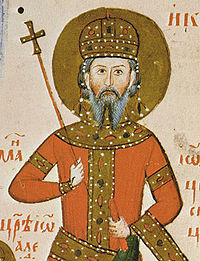
Ivan Alexander (Bulgarian: Иван Александър, transliterated Ivan Aleksandǎr; also known as John Alexander, ruled as Emperor (Tsar) of Bulgaria from 1331 to 1371, during the Second Bulgarian Empire. The date of his birth is unknown. He died on February 17, 1371. The long reign of Ivan Alexander is considered a transitional period in Bulgarian medieval history. Ivan Alexander began his rule by dealing with internal problems and external threats from Bulgaria's neighbours, the Byzantine Empire and Serbia, as well as leading his empire into a period of economic recovery and cultural and religious renaissance.
However, the emperor was later unable to cope with the mounting incursions of Ottoman forces, Hungarian invasions from the northwest and the Black Death. In an ill-fated attempt to combat these problems, he divided the country between his two sons,thus forcing it to face the imminent Ottoman conquest weakened and divided. (Read more. . .)
Portal:Middle Ages/Selected biography/13

Joan of Arc (French: Jeanne d'Arc, ca. 1412– 30 May 1431), nicknamed "The Maid of Orléans" (French: La Pucelle d'Orléans), is a folk heroine of France and a Roman Catholic saint. She was born a peasant girl in what is now eastern France. Claiming divine guidance, she led the French army to several important victories during the Hundred Years' War, which paved the way for the coronation of Charles VII of France. She was captured by the Burgundians, transferred to the English in exchange for money, put on trial by the pro-English Bishop of Beauvais Pierre Cauchon for charges of "insubordination and heterodoxy", and was burned at the stake for heresy when she was 19 years old.
Twenty-five years after her execution, an inquisitorial court authorized by Pope Callixtus III examined the trial, pronounced her innocent, and declared her a martyr. Joan of Arc was beatified in 1909 and canonized in 1920. She is – along with St. Denis, St. Martin of Tours, St. Louis, and St. Thérèse of Lisieux – one of the patron saints of France. Joan said she had received visions from God instructing her to support Charles VII and recover France from English domination late in the Hundred Years' War. The uncrowned King Charles VII sent her to the siege of Orléans as part of a relief mission. She gained prominence when she overcame the dismissive attitude of veteran commanders and lifted the siege in only nine days. Several additional swift victories led to Charles VII's coronation at Reims.
To the present day, Joan of Arc has remained a significant figure in Western civilization. From Napoleon I onward, French politicians of all leanings have invoked her memory. Famous writers and composers who have created works about her include: William Shakespeare (Henry VI, Part 1), Voltaire (The Maid of Orleans), Friedrich Schiller (The Maid of Orleans), Giuseppe Verdi (Giovanna d'Arco), Pyotr Ilyich Tchaikovsky (The Maid of Orleans), Mark Twain (Personal Recollections of Joan of Arc), Arthur Honegger (Jeanne d'Arc au bûcher), Jean Anouilh (L'Alouette), Bertolt Brecht (Saint Joan of the Stockyards), George Bernard Shaw (Saint Joan), Maxwell Anderson (Joan of Lorraine), Leonard Cohen (Joan of Arc), and Orchestral Manoeuvres in the Dark (Joan of Arc). Cultural depictions of Joan of Arc have continued in film, theatre, television, video games, music, and performances. (Read more. . .)
Portal:Middle Ages/Selected biography/14
Khālid ibn al-Walīd (Arabic: خالد بن الوليد; 592–642) also known as Sayf Allāh al-Maslūl (the Drawn Sword of God), was a companion of the Islamic prophet Muhammad. He is noted for his military tactics and prowess, commanding the forces of Medina under Muhammad and the forces of his immediate successors of the Rashidun Caliphate; Abu Bakr and Umar ibn Khattab. It was under his military leadership that Arabia, for the first time in history, was united under a single political entity, the Caliphate. Commanding the forces of the nascent Islamic State, Khalid was victorious in over a hundred battles, against the forces of the Byzantine-Roman Empire, Sassanid-Persian Empire, and their allies, in addition to other Arab tribes. His strategic achievements include the conquest of Arabia, Persian Mesopotamia and Roman Syria within several years from 632 to 636. He is also remembered for his decisive victories at Yamamah, Ullais, and Firaz, and his tactical successes at Walaja and Yarmouk.
Khalid ibn al-Walid (Khalid son of al-Walid, lit. Immortal son of the Newborn) was from the Meccan tribe of Quraysh, from a clan that initially opposed Muhammad. He played a vital role in the Meccan victory at the Battle of Uhud against the Muslims. He converted to Islam, and joined Muhammad after the Treaty of Hudaybiyyah and participated in various expeditions for him, such as the Battle of Mu'tah. After some Muslim emissaries were killed, at the Battle of Mu'tah 3,000 Muslims took on a combined force of 200,000 Roman soldiers and their Arab allies. It was the first battle between the Romans and the Muslims. Khalid ibn Al-Walid reported that the fighting was so intense, that he used nine swords, which broke in the battle. Khalid took over after Zayd ibn Haritha, then Jafar ibn Abi Talib, then Abdullah ibn Rawahah were killed. After Muhammad's death, he played a key role in commanding Medinan forces for Abu Bakr in the Ridda wars, conquering central Arabia and subduing Arab tribes. He captured the Sassanid Arab client Kingdom of Al-Hirah, and defeated the Sassanid Persian forces during his conquest of Iraq (Mesopotamia). He was later transferred to the western front to capture Roman Syria and the Byzantine Arab client state of the Ghassanids. Even though Umar later relieved him of high command, he nevertheless remained the effective leader of the forces arrayed against the Byzantines during the early stages of the Byzantine–Arab Wars. Under his command, Damascus was captured in 634 and the key Arab victory against the Byzantine forces was achieved at the Battle of Yarmouk (636), which led to the conquest of the Bilad al-Sham (Levant). In 638, at the zenith of his career, he was dismissed from military services.
Portal:Middle Ages/Selected biography/15

James I, King of Scots (July 1394 – 21 February 1437), was the youngest of three sons of King Robert III and Annabella Drummond and was probably born in late July 1394 in Dunfermline. By the time he was eight years of age both of his elder brothers were dead—Robert had died in infancy, but David Stewart, Duke of Rothesay, died under suspicious circumstances in Falkland Castle while being detained by his uncle, Robert Stewart, Duke of Albany. Although parliament exonerated Albany, fears for James's safety grew during the winter of 1405–6 and plans were made to send him to France. In February 1406, James, in the company of nobles loyal to King Robert III, clashed with those of the Earl of Douglas, forcing the prince to take temporary refuge on the Bass Rock in the Firth of Forth. He remained there until mid-March, when he boarded a vessel bound for France, but English pirates captured the ship on 22 March and delivered James to Henry IV of England. A few days later, on 4 April Robert III died, and the 12 year-old uncrowned King of Scots began his 18-year detention.
James was given a good education at the English court, where he developed respect for English methods of governance and for Henry V to the extent that he served in the English army against the French during 1420–1. The Duke of Albany's son, Murdoch, held a prisoner in England following his capture in 1402, was traded for Henry Percy, Earl of Northumberland, in 1416. By the time James was ransomed in 1424, Murdoch had succeeded his father to the dukedom and the governorship of Scotland. In April 1424 James, accompanied by his wife Joan Beaufort, daughter of the Earl of Somerset, returned to Scotland. It was not altogether a popular re-entry to Scottish affairs, since James had fought on behalf of Henry V and at times against Scottish forces in France. Additionally, his £40,000 ransom meant increased taxes to cover the repayments and the detention of Scottish nobles as collateral. Despite this, James also held qualities that were admired. The contemporary Scotichronicon by Walter Bower described James as excelling at sport and appreciative of literature and music. Unlike his father and grandfather he did not take mistresses, but had many children by his consort, Queen Joan. The king had a strong desire to impose law and order on his subjects, but applied it selectively at times.
To bolster his authority and secure the position of the crown, James launched pre-emptive attacks on some of his nobles beginning in 1425 with his close relatives the Albany Stewarts. This resulted in the execution of Duke Murdoch. In 1428 James detained Alexander, Lord of the Isles, while attending a parliament in Inverness. Archibald, Earl of Douglas, was arrested in 1431, followed by George, Earl of March, in 1434. The plight of the ransom hostages held in England was ignored and the repayment money was diverted into the construction of Linlithgow Palace and other grandiose schemes.
In August 1436, James failed humiliatingly in his siege of Roxburgh Castle and then faced an ineffective attempt by Sir Robert Graham to arrest him at a general council. James was murdered at Perth on the night of 20–1 February 1437 in a failed coup by his uncle and former ally Walter Stewart, Earl of Atholl. Queen Joan, although wounded, escaped to the safety of Edinburgh Castle, where she was reunited with her son James II. (Read more. . .)
Portal:Middle Ages/Selected biography/16

Sviatoslav I Igorevich (Old East Slavic: С~тославъ / Свѧтославъ Игорєвичь, Sventoslavŭ / Svantoslavŭ Igorevičǐ; Russian: Святослав Игоревич, Sviatoslav Igorevich; Ukrainian: Святослав Ігорович, Sviatoslav Ihorovych; Bulgarian: Светослав, Svetoslav, Greek: Σφενδοσθλάβος, Sphendosthlabos) (c. 942 – March 972), also spelled Svyatoslav, was a prince of Rus'. The son of Igor of Kiev and Olga, Sviatoslav is famous for his incessant campaigns in the east and south, which precipitated the collapse of two great powers of Eastern Europe—Khazaria and the First Bulgarian Empire; he also conquered numerous East Slavic tribes, defeated the Alans and the Volga Bulgars, and at times was allied with the Pechenegs and Magyars.
His decade-long reign over Rus' was marked by rapid expansion into the Volga River valley, the Pontic steppe and the Balkans. By the end of his short life, Sviatoslav carved out for himself the largest state in Europe, eventually moving his capital from Kiev (modern-day Ukraine) to Pereyaslavets (modern day Romania) on the Danube in 969. In contrast with his mother's conversion to Christianity, Sviatoslav remained a staunch pagan all of his life. Due to his abrupt death in ambush, Sviatoslav's conquests, for the most part, were not consolidated into a functioning empire, while his failure to establish a stable succession led to fratricidal feud among his sons, resulting in two of his three sons being killed. (Read more. . .)
Portal:Middle Ages/Selected biography/17
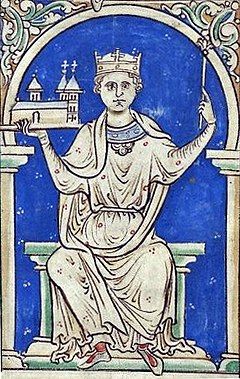
Stephen (c. 1092/6 – 25 October 1154), often referred to as Stephen of Blois (French: Étienne de Blois, Medieval French: Estienne de Blois), was a grandson of William the Conqueror. He was King of England from 1135 to his death, and also the Count of Boulogne in right of his wife. Stephen's reign was marked by the Anarchy, a civil war with his cousin and rival, the Empress Matilda. He was succeeded by Matilda's son, Henry II, the first of the Angevin kings.
Stephen was born in the County of Blois in middle France; his father, Count Stephen-Henry, died while Stephen was still young, and he was brought up by his mother, Adela. Placed into the court of his uncle, Henry I, Stephen rose in prominence and was granted extensive lands. Stephen married Matilda of Boulogne, inheriting additional estates in Kent and Boulogne that made the couple one of the wealthiest in England. Stephen narrowly escaped drowning with Henry I's son, William Adelin, in the sinking of the White Ship in 1120; William's death left the succession of the English throne open to challenge. When Henry I died in 1135, Stephen quickly crossed the English Channel and with the help of his brother Henry of Blois, a powerful ecclesiastic, took the throne, arguing that the preservation of order across the kingdom took priority over his earlier oaths to support the claim of Henry I's daughter, the Empress Matilda.
The early years of Stephen's reign were largely successful, despite a series of attacks on his possessions in England and Normandy from David I of Scotland, Welsh rebels and the Empress Matilda's husband, Geoffrey of Anjou. In 1138 the Empress's half-brother Robert of Gloucester rebelled against Stephen, threatening civil war. Together with his close advisor, Waleron de Beaumont, Stephen took firm steps to defend England, including arresting a powerful family of bishops. When the Empress and Robert invaded in 1139, however, Stephen was unable to rapidly crush the revolt, which took hold in the south-west of England. Captured at the battle of Lincoln in 1141, Stephen was abandoned by many of his followers and lost control of Normandy. Stephen was only freed after his wife and William of Ypres, one of his military commanders, captured Robert at the Rout of Winchester, but the war dragged on for many years with neither side able to win an advantage.
Stephen became increasingly concerned with ensuring that his son, Eustace, would inherit his throne after him. The king attempted to convince the church to agree to crown Eustace to reinforce his claim: Pope Eugene III refused and Stephen found himself in a sequence of increasingly bitter arguments with his senior clergy. In 1153 the Empress's son, Henry FitzEmpress, invaded England and built an alliance of powerful regional barons to support his claim for the throne. The two armies met at Wallingford but neither side's barons were keen to fight another pitched battle. Stephen began to examine a negotiated peace, a process hastened by the sudden death of Eustace. Stephen and Henry agreed the Treaty of Winchester later in the year, in which Stephen recognised Henry as his heir in exchange for peace, passing over William, Stephen's second son. Stephen died the following year. Modern historians have extensively debated the extent to which Stephen's personality, external events or the weaknesses in the Norman state contributed to this prolonged period of civil war. (Read more. . .)
Portal:Middle Ages/Selected biography/18
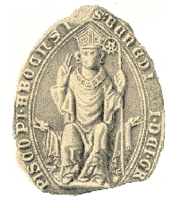
Saint Henry (pyhä Henrik or piispa Henrik in Finnish, Biskop Henrik or Sankt Henrik in Swedish, Henricus in Latin; died allegedly 20 January circa 1156) was a medieval English clergyman. He came to Sweden with cardinal Nicholas Breakspeare in 1153 and was probably designated to the new Archbishop of Uppsala, but the independent church province of Sweden could be established only in 1164 after the civil war was over, and Henry would have been sent to organize the Church in Finland, where Christians had existed already at least two centuries. According to legends, he entered Finland together with King Eric the Saint of Sweden and died as a martyr, becoming a central figure in the local Roman Catholic Church. However, the authenticity of the accounts of his life, ministry, and death are widely disputed.
Together with his alleged murderer Lalli, Henry remains one of the most recognized people from the early history of Finland. His feast is celebrated by the Roman Catholic Church of Finland, and he is commemorated in several Protestant liturgical calendars. (Read more. . .)
Portal:Middle Ages/Selected biography/19

Jogaila, later ⓘ[nb 1] (ca. 1351/1362 – 1 June 1434) was Grand Duke of Lithuania (1377–1434), jure uxoris King of Kingdom of Poland (1386–1399), and sole King of Poland (1399–1434). He ruled in Lithuania from 1377, at first with his uncle Kęstutis. In 1386 in Kraków he was baptized as Władysław, married the young queen regnant Jadwiga of Poland, and was crowned King of Poland as Władysław II Jagiełło. In 1387 he converted Lithuania to Christianity. His own reign in Poland started in 1399, upon death of Queen Jadwiga, and lasted a further thirty-five years and laid the foundation for the centuries-long Polish–Lithuanian union. Władysław II was the founder of the Jagiellon dynasty that bears his name, while pagan Jogaila was an heir to the already established house of Gediminids in Grand Duchy of Lithuania; the royal dynasty ruled both states until 1572,[nb 2] and became one of the most influential dynasties in the late medieval and early modern Central and Eastern Europe. During his reign Polish-Lithuanian state was the greatest Kingdom of the Christian world.[4]
Jogaila was the last pagan ruler of medieval Lithuania. After he became King of Poland, as a result of Union of Krewo, the newly formed Polish-Lithuanian union confronted the growing power of the Teutonic Knights. The allied victory at the Battle of Grunwald in 1410, followed by the Peace of Thorn (1411), secured the Polish and Lithuanian borders and marked the emergence of the Polish–Lithuanian alliance as a significant force in Europe. The reign of Władysław II Jagiełło extended Polish frontiers and is often considered the beginning of Poland's Golden Age. (Read more. . .)
- ^ He is known under a number of names: Lithuanian: Jogaila Algirdaitis; Polish: Władysław II Jagiełło; Belarusian: Jahajła (Ягайла). See also: Jogaila (Władysław II Jagiello): names and titles.
- ^ Anna Jagiellon last member of royal Jagiellon family died in 1596.
Portal:Middle Ages/Selected biography/20
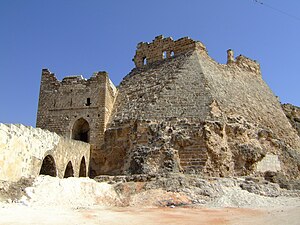
Majd ad-Dīn Usāma ibn Murshid ibn ʿAlī ibn Munqidh al-Kināni al-Kalbi (also Usamah, Ousama, etc.; Arabic: أسامة بن منقذ) (July 4, 1095 – November 17, 1188) was a medieval Muslim poet, author, faris (professional warrior), and diplomat from the Banu Munqidh dynasty of Shaizar in northern Syria. His life coincided with the rise of several medieval Muslim dynasties, as well as the arrival of the First Crusade and the establishment of the crusader states.
He was the nephew of the emir of Shaizar and probably expected to rule Shaizar himself, but he was exiled in 1131 and spent the rest of his life serving other leaders. He was a courtier to the Burids, Zengids, and Ayyubids in Damascus, serving the famous Zengi, Nur ad-Din, and Saladin over a period of almost fifty years. He also served the Fatimid court in Cairo, as well as the Artuqids in Hisn Kayfa. He often meddled in the politics of the courts in which he served, and he was exiled from both Damascus and Cairo.
During and immediately after his life he was most famous as a poet and adib (a "man of letters"). He wrote many poetry anthologies, such as the Kitab al-'Asa ("Book of the Staff"), Lubab al-Adab ("Kernels of Refinement"), and al-Manazil wa'l-Diyar ("Dwellings and Abodes"), and collections of his own original poetry. For modern readers, however, he is most well known for his Kitab al-I'tibar ("Book of Learning by Example" or "Book of Contemplation"), which contains lengthy descriptions of the crusaders, whom he interacted with on many occasions, and some of whom he considered friends, although he generally saw them as ignorant foreigners.
Most of his family was killed in an earthquake at Shaizar in 1157. He died in Damascus in 1188, at the age of 93, a remarkably advanced age for the time. (Read more. . .)
- ^ Turvey pp. 91–2
- ^ In a charter concerning a grant to Chertsey Abbey he uses princeps Wall[ie] while a charter dated 1184 concerning Strata Florida Abbey uses Walliar[um] princeps. See Pryce (2005) pp. 96–7, 168–9, 171–4
- ^ Forsyth discusses the various forms of Óengus's name, also providing Ungus(t) as an alternative Pictish form.
- ^ Anna Boczkowska, Sarkofag Władysława II Jagiełły i Donatello, Gdańsk 2011, p. 27.
